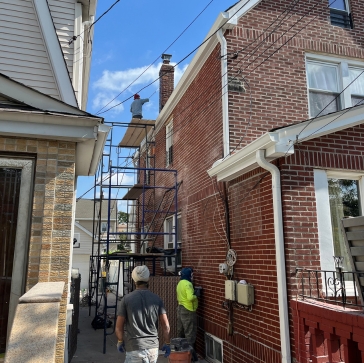


When it comes to masonry, the beauty and durability of work often rely on the details- one of the most important types of mortar joints is brick pointing. Mortar joints are not just used for functionality but they also play a vital role in enhancing the looks of your property. This blog explains what brick pointing is, its different types and how it helps to add structural integrity to your property.
Ever wonder why those mortar joints between brick and stone start crumbling? This is where Brick Pointing comes in! Brick pointing process involves finishing mortar joints in the masonry, removing the old damaged mortar and replacing them with new material. The pointing service is not just about aesthetics, it is also about protecting your property from different harsh weather elements, water infiltration, and structural issues.
A brick pointing contractor in NYC utilizes different techniques, each offering visual and functional benefits. Let’s explore some of the key types of pointing generally used in masonry construction services.
Flush pointing is a prevalent and stable technique in which mortar joints are filled and ground to flush with the masonry surface. This seamless finish enhances the structure’s formation while reducing spaces that could gather dust or water, boosting cleanliness and durability.
Recessed pointing entails filling mortar joints and pushing them back into the wall surface, to achieve at least 5 mm depth in the wall. This method enhances the depth and shadow lines along the upper edge of the masonry, resulting in a distinctive and attractive aesthetic.
Beaded pointing includes an open groove in the mortar joint, created using a steel tool. As the name defines, this pointing service offers a beaded look to the linear edge of the masonry. Although, it is more susceptible to early damage as compared to other pointing techniques.
The struck pointing process involves creating a sloping profile in mortar joints. This slope enables quick drainage of rainwater, minimizing water retention on the masonry surface.
Much similar to flush pointing, this technique comes with the extra advantage of a central groove created using a pointer tool. The groove creates a visual element improving the aesthetic appeal of the property.
The tuck pointing process involves filling the mortar joints at least 5 mm wide and 3 mm deep to create a precise groove. This groove is then filled with white cement putty, leaving a slight projection that contrasts sharply with the pressed mortar, thereby enhancing the overall appearance.
Identical to keyed pointing, this pointing method creates a V-shaped groove with the joint. This pattern is designed using a V-shaped tool creating a distinct and visually appealing profile.
The weathered pointing method involves pushing mortar into the joints and precisely cutting back the top part of the lime mortar from the horizontal joints by 3-6 mm. This method creates a sloped effect, resulting in joints that have a weathered and worn appearance.
Choosing the right type of mortar joint for your brick pointing project involves both considering aesthetics as well as functionality. If you are unsure which type of pointing is the best choice for your project, contact Oberoi Brick Pointing, the Brick repair contractor in NYC and we will provide you with all the briefs and insights about pointing services and help you achieve the best outcomes.